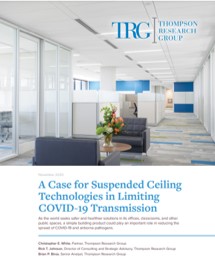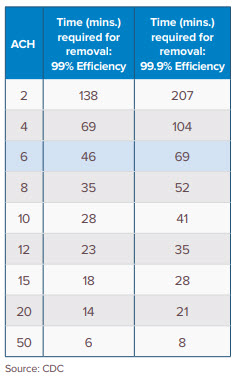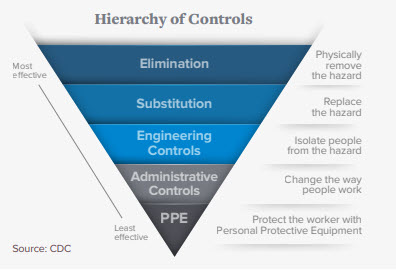
A Case for Suspended Ceiling Technologies in Limiting COVID-19 Transmission
Christopher E. White, Partner, Thompson Research Group
Rick T. Johnson, Director of Consulting and Strategic Advisory, Thompson Research Group
Brian P. Biros, Senior Analyst, Thompson Research Group
As the world seeks safer and healthier solutions in its offices, classrooms, and other public spaces, a simple building product could play an important role in reducing the spread of COVID-19 and airborne pathogens.
A Healthy Return to the Office Includes a Focus on Air Quality
Since the outbreak of COVID-19 in the United States, it is estimated that more than one-third of the workforce has shifted to a “work from home” (WFH) environment. Either by government mandate, employer policy, or employee choice, the American worker has performed job responsibilities outside of their everyday office. As questions arise on true WFH productivity, especially in the face of mounting evidence of widespread health issues and the increased burden placed on women as primary care providers, employers and employees alike are anticipating a return to the traditional office space. A critical part of re-entering the office is assurance that employees are provided a safe and healthy environment. To that end, landlords and employers should take precautions to comply with safety guidelines to minimize exposure to COVID-19 and other airborne pathogens. Proper measures go beyond safe distancing and cleaning surfaces. To ensure employees are best protected, air flow and air quality should be a primary focus.
Updated Guidance Suggests COVID-19 Can Spread Via Aerosols
According to the Centers for Disease Control and Prevention (CDC), COVID-19 (or virus SARS-CoV-2) is primarily spread between humans in close contact, less than 6 feet apart, through respiratory droplets when an infected person coughs or sneezes.1 These droplets are measured as 5 microns in diameter or larger. When these droplets come in contact with others or land on surfaces, the chances of contamination rise. Wearing masks, social distancing, and cleaning surfaces are strongly encouraged by the CDC and other health organizations to prevent the spread of COVID-19.
On October 5, 2020, however, the CDC updated its guidance stating infections can be spread by airborne transmission from smaller droplets that may remain airborne for 3 hours or longer, carry beyond 6 feet, and importantly, remain contagious. A study conducted by Tulane University School of Medicine concluded aerosols less than 5 microns in diameter maintain infectivity and persists longer than expected when compared to results of prior studies on other viruses. The study suggests only a slight reduction of infectivity in aerosol suspensions with similar sized particles.2 Environmental Protection Agency (EPA) research states
“There is growing evidence that the SARS-CoV-2 virus remains airborne in indoor environments for hours, potentially increasing in concentration over time. Therefore, unless adequate precautions are taken, the longer a space is occupied, the greater the potential for airborne transmission of the virus.”3
CDC notes circumstances under which airborne transmission of SARS-CoV-2 appears to have occurred include:
- Enclosed spaces within which an infectious person either exposed susceptible people at the same time or to which susceptible people were exposed shortly after the infectious person had left the space.
- Prolonged exposure to respiratory particles, often generated with expiratory exertion (e.g., shouting, singing, exercising) that increased the concentration of suspended respiratory droplets in the air space.
- Inadequate ventilation or air handling that allowed a build-up of suspended small respiratory droplets and particles.
Source: CDC
Guangzhou Suspected Transmission Via Aerosol
The CDC has concluded, after a detailed investigation, that COVID-19 was most likely transmitted via droplets spread by strong airflow in a restaurant in Guangzhou, China. The CDC notes the transmission cannot be explained by droplets transmission (larger than 5 microns) alone and transmission was prompted by air-conditioned ventilation.
In January of 2020 having just arrived from Wuhan, a family ate at a restaurant (table A) unaware of the infection of member A1. Later that day, A1 experienced onset of fever and cough and went to the hospital. Two other families sat at tables greater than 1 meter apart (tables B and C) and were exposed to A1 for 53 and 73 minutes, respectively, by the strong flow from the air conditioner across tables A, B, and C.
On this day, January 24, 83 customers ate at the restaurant. By February 5, all 10 customers sitting at tables A, B, and C while member A1 was present had contracted COVID-19. None of the other 73 customers in the restaurant developed symptoms during a 14-day quarantine.
Viral Dose Could Determine COVID-19 Severity
While additional studies are needed, it is believed initial exposure levels of COVID-19 coincide with the severity of sickness. This follows a long held theory stating “the severity of the disease is proportionate to the viral inoculum received,” according to the New England Journal of Medicine and is backed by studies correlating initial exposure to severity for influenza and severe acute respiratory syndrome (SARS).4 Early studies in Spain support “a greater viral inoculum at the time of SARS-CoV-2 exposure might determine a higher risk of severe COVID-19.”5 If initial exposure, or viral dose, is directly correlated to the severity of sickness, steps should be taken to lower viral inoculum such as wearing masks, social distancing, and reducing aerosol contaminants that may linger in closed, inadequately ventilated spaces.
Today's Office Environment
Today’s office environment has evolved over time. Recently, the trend has been to create open space for a more collaborative environment. Corporate America, however, is largely housed in space created 30+ years ago. Trends pre-COVID and outdated office spaces are no longer viable to ensure healthy environments.
Office Environment Concerns
With a better understanding of today’s workplace, the challenges facing a return to the office are clear. Re-engaging people outside of family, contact with unknowingly infected persons, and repeated exposure to cleaning chemicals, all in confined spaces, could meaningfully increase employee health risks. These risks are even higher for persons aged 65 and older. Research from the World Health Organization (WHO) suggests environments heavily populated with poor or insufficient air flow raises infection rates. The WHO further encourages good environmental ventilation in all closed settings.6
The WHO notes outbreaks of COVID-19 in places of work by aerosol transmission cannot be ruled out “where there are crowded and inadequately ventilated spaces where infected persons spend long periods of time with others.”7 In addition to wearing masks, hand washing, and cleaning of surfaces, the CDC recommends “considering taking steps to improve ventilation” in buildings such as offices and schools. A key component of improving air quality is increasing the percentage of natural airflow (outdoor air) as much as possible by opening windows to dilute indoor air. As many of today’s offices contain permanently closed windows, a greater weight should be placed on improving and upgrading heating, ventilation, and air-conditioning (HVAC) systems. In May of 2020, the CDC updated its “Guidance for Businesses and Employers Responding to Coronavirus Disease 2019” suggesting employers seeking to resume normal or phased business operations improve the building ventilation system.8
ASHRAE Recommendations on HVAC
In providing guidance on implementing safe and healthy workplace procedures for the return to offices or schools, the CDC cites HVAC and airflow recommendations from the American Society of Heating, Refrigerating and Air-Conditioning Engineers (ASHRAE). In its “Position Document on Infectious Aerosols” published in April 2020, ASHRAE states while ventilation systems cannot address all aspects of infectious control, “changes to building operations, including the operation of heating, ventilating, and air-conditioning systems, can reduce airborne exposures.” ASHRAE further clarifies “directional airflow can create clean-to-dirty flow patterns and move infectious aerosols to be captured and exhausted.” The document lists several strategies building owners and employers should consider to potentially reduce occupant exposure to infectious aerosols. Among the recommendations are strategies to improve ventilation through dilution, airflow patterns, filtration, and pressurization. ASHRAE states “these techniques, when applied properly, can reduce the risk of transmission of infectious diseases through aerosols.”
HVAC Limitations
Commercial HVAC systems are commonly installed to meet the minimum demands of heating and cooling and were never intended to be a line of defense against the spread of a global pandemic. A few of the challenges in implementing the ASHRAE techniques listed above include higher energy costs, decreased air flow as higher rated Minimum Efficiency Reporting Value (MERV) filters are installed, and reduced comfort levels as the system may not be able to effectively provide heating and cooling. An expensive solution to potentially solve these issues would be to install a new, upgraded HVAC system. A less expensive, easier install, and potentially more effective solution could be utilizing suspended ceiling technologies in combination with improved filtration.
ASHRAE cites the following as ventilation-related strategies on combating the spread of infectious aerosols:
- Airflow – As air is the primary carrier of heat, moisture, and contaminants, a proper flow path is essential to maintaining quality air. A proper flow path helps ensure airborne pathogens are removed from a room, lowering the risk of infectivity.
- Pressurization – A technique used to control the flow of a space. Controlling the flow of air, either in to or out of a room, can help prevent the passage of contaminants between spaces.
- Filtration – A potentially highly effective method of reducing pathogens from the air by trapping and holding contaminants flowing into the system and preventing the further movement of pathogens.
- Dilution – The process of supplying and exhausting large amounts of air thereby introducing uncontaminated air and removing contaminated air.
Suspended Ceiling Technology’s Role in Containing COVID-19 Transmission
To help provide a safer and healthier environment, a number of suspended ceiling tile technologies may be implemented. Below we outline three simple solutions available today. These solutions may provide a step in limiting the transmission of COVID-19 and airborne pathogens.
Leakage Control and Efficiency
Specially engineered suspended ceiling systems are a proven technology used in patient rooms, clean rooms, and laboratories to help prevent the spread of contaminants. In some applications, a gasket is placed between the ceiling tile and grid to form a tight seal and prevent the spread of pathogens into the plenum and into other areas of the building. In addition to helping contain pathogens, the tighter seal helps reduce air leaks and can increase the efficiency of HVAC filtration. A more efficient system would allow more air, and potential contaminants, to be exhausted out of the room and into filters capturing and cleaning the air of pathogens.
Structural
One of the challenges facing a return to the office is addressing the recent trend of collaborative workspaces and larger, open-air industrial type settings with higher structural ceiling exposing duct and pipe work, possibly the least optimal environment to prevent transmission. The installation of a suspended ceiling allows for the easy configuration of permanent or modular individual offices helping employees maintain social distance and the potential spread of pathogens.
Cleanability
Cleaning and disinfecting desks, keyboards, door handles, countertops and other office features is essential to providing a safer, healthier space. But what about ceilings that can comprise 20% or more of total office surface (ceilings, walls, floors)? While heavy contaminants may fall, aerosols can rise and cling to ceilings. Certain ceiling tiles and wall solutions can be cleaned based on CDC recommendations by either wiping, spraying, or using a fogger to eliminate pathogens and viruses.
Armstrong World Industries Ceiling Technology Solutions
Armstrong World Industries (AWI) offers a wide range of suspended ceiling technologies to help ensure a safer, healthier environment in the post-COVID world. These products fall under the indoor air quality platform including the “CleanAssure” and the “AirAssure” family of solutions. The AIRASSURE product line, announced on October 26, 2020, incorporates a self-sealing gasket on the ceiling tile to help prevent air leakage. As part of the official launch, AWI announced a partnership with a leading manufacturer of medical lighting equipment to provide a customized version of an air purification system to work in conjunction with the new AIRASSURE panels and other Armstrong ceiling solutions.
CLEANASSURE
The CLEANASSURE family of products also includes the CALLA, OPTIMA and ULTIMA HEALTH ZONE series as well as the LYRA and KITCHEN ZONE series. These smooth ceiling tiles can be cleaned by wiping, spraying or fogging. In particular, the CALLA, OPTIMA and ULTIMA series are rated for Clean Rooms up to ISO Class 5. The CLEANASSURE family of products are also bacteria and mold/mildew resistant for extra protection.
AIRASSURE
The AIRASSURE family of products builds upon the CLEANASSURE line by incorporating a gasket onto the CALLA and ULTIMA HEALTH ZONE series of tiles. This system has been proven to increase the effectiveness of in-ceiling air filtration by up to 40%. Increasing the effectiveness and efficiency of current HVAC systems could be one of the keys to controlling the transmission of COVID-19 in a return to offices, schools, and other enclosed spaces.
A universal metric used to measure the amount of air entering and exiting a room is air changes per hour (ACH), where the rate is calculated based on the full height of the structural ceiling. The incorporation of a suspended ceiling tile system, however, has the effect of reducing the ceiling height, thus the volume of air needing to be exhausted, by several feet. The importance of this technology becomes clear when examining data from the CDC’s “2019 Guidelines for Environmental Infection Control in Health-Care Facilities.” The provided table indicates the approximate time needed to remove airborne contaminates from a room based on ACH. For example, at 6 ACH it takes 46 mins to achieve 99% efficiency of airborne contaminate removal from a room. By improving to 8 ACH, the time required to achieve the same efficiency is reduced to 35 minutes, or nearly 25%. The installation of a suspended ceiling reduces air volume, thus increasing ACH and lowering the time it takes to clear an office of an airborne contaminates. Incorporating the AIRASSURE gasketed ceiling tile system provides even more control over the volume of air in a room.

In furthering its product offerings to address the COVID-19 pandemic, AWI has partnered with Medical Illumination International (MI), a leading manufacturer of medical lighting solutions. By combining MI’s VIDASHIELD UV24 air purification system with the new AIRASSURE panel and other Armstrong ceiling solutions, the new design uses ultraviolet light to deactivate pathogens. Titled the AWI VIDASHIELD UV24, the system utilizes “patented, scientifically proven UV-C air cleaning technology that continuously cleans and reduces active levels of contaminants.” Test results show the system neutralizes 97% of infectious pathogens in aerosols during the first pass of air through the system. Each product can treat a volume of air equivalent to an 8’ x 10’ x 10’ room four times per hour.
VIDASHIELD UV24
Key Points:
- 24” wide x 48” long x 6” high
- 42 lbs.
- 60 watts
- 120-277 voltage, 347 VAC
- Dedicated UV ballast
- Ultra-quiet air circulation fans
- 50 CFM air volume
- MERV 6 high flow air particle filter
- ULTIMA HEALTH ZONE ceiling panel infill
Cost Effective Solutions
One worrisome factor that could be preventing the return to enclosed spaces is the potential cost of implementing recommended measures that reduce COVID-19 transmission. The Armstrong product lines, CLEANASSURE, AIRASSURE, and VIDASHIELD UV24, provide effective, price conscience solutions and are easily retro-fitted into existing grids. AIRASSURE also enables the transition to negative or positive-controlled environments.
Summary
As the nation reopens its economy, schools, and businesses, ensuring a safe and healthy environment is critical. The confidence of knowing systems and facilities have been implemented or upgraded to potentially reduce the transmission of COVID-19 is paramount before the return of employees, students, and others exposed to public and semi-public spaces. Suspended ceiling technologies can play an important role as stand-alone solutions or in conjunction with other products to reduce the spread of infectious aerosols and potentially help reduce the cost of other system upgrades. Governments, education systems, and businesses should examine their facilities to determine whether suspended ceiling technologies could help prevent the spread of COVID-19 and other airborne pathogens.
Additional Resources
A Case for Suspended Ceiling Technologies
A simple building product could play an important role in reducing the spread of COVID-19 & airborne pathogens.
Encompass Health Rehabilitation Hospital
Negative pressure isolation room eliminates pressure variability with AIRASURE Ceiling Panels.
Ceilings Designed to Improve Airflow and Air Quality
Utilize suspended ceiling technologies in combination with improved filtration for a more effective solution.
1 Centers for Disease Control and Prevention, “How COVID-19 Spreads”, October 28, 2020, cdc.gov
2 AC Fears, WB Klimstra, P Duprex, A Hartman, SC Weaver, KS Plante, et al, “Persistence of Severe Acute Respiratory Syndrome Coronavirus 2 in Aerosol Suspensions,” Emerging Infectious Diseases, September 2020, cdc.gov
3 Environmental Protection Agency, “Science and Technical Resources related to Indoor Air and Coronavirus (COVID-19), epa.gov
4 Monica Gandhi and George Rutherford, “Facial Masking for Covid-19 – Potential for ‘Variolation’ as We Await a Vaccine”, September 8, 2020, nejm.org
5 Maria Guallar, et al, “Inoculum at the time of SARS-CoV-2 exposure and the risk of disease severity,” August 2020, sciencedirect.com
6 World Health Organization, “Transmission of SARS-CoV-2: Implications for infection prevention precautions,” July 9, 2020, who.int
7 World Health Organization, “Coronavirus disease (COVID-19): How is it transmitted?”, who.int
8 Centers for Disease Control and Prevention, “Interim Guidance for Business and Employers Responding to Coronavirus Disease 2019, May 2020,” May 6, 2020, cdc.gov
Disclaimer
This report is for informational purposes only. It represents a preliminary view on how suspended ceiling products and related technologies may reduce the spread of airborne pathogens in an office environment. At the time of publication, these products have not been specifically tested and proven to reduce or prevent the spread of Covid-19.
Copyright ©2020 Thompson Research Group
